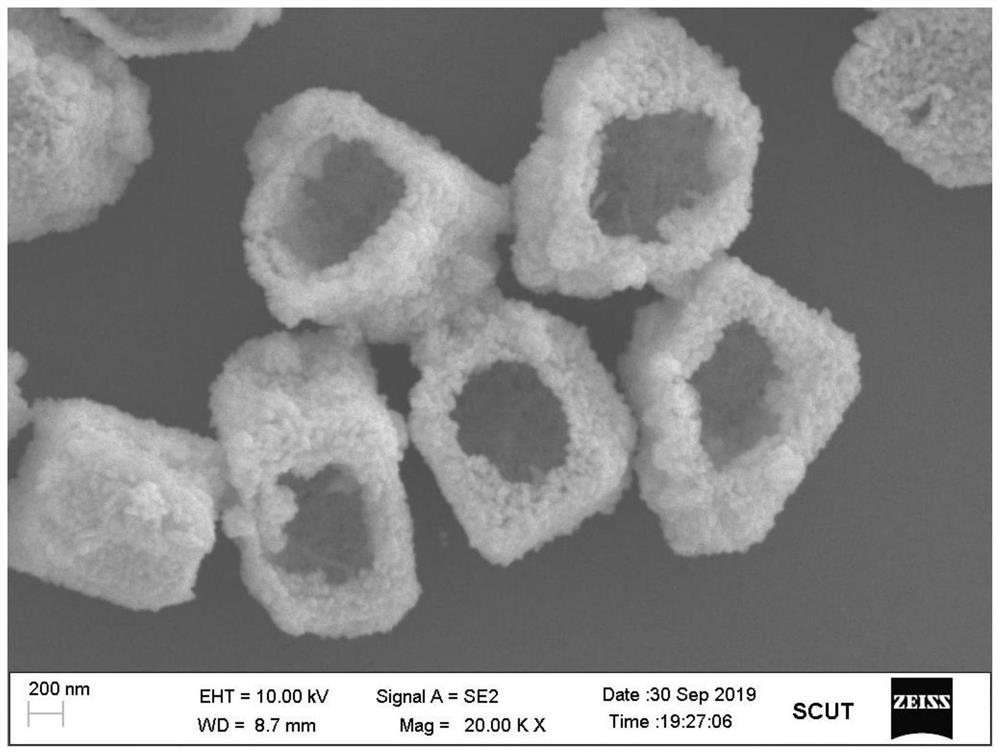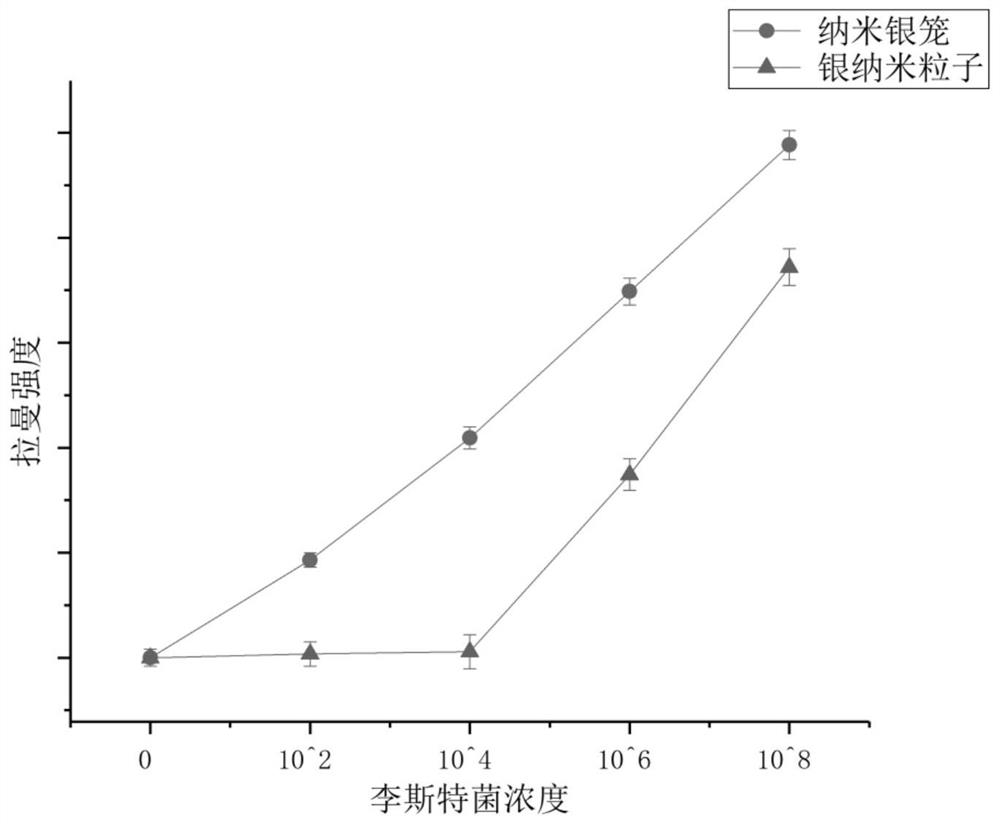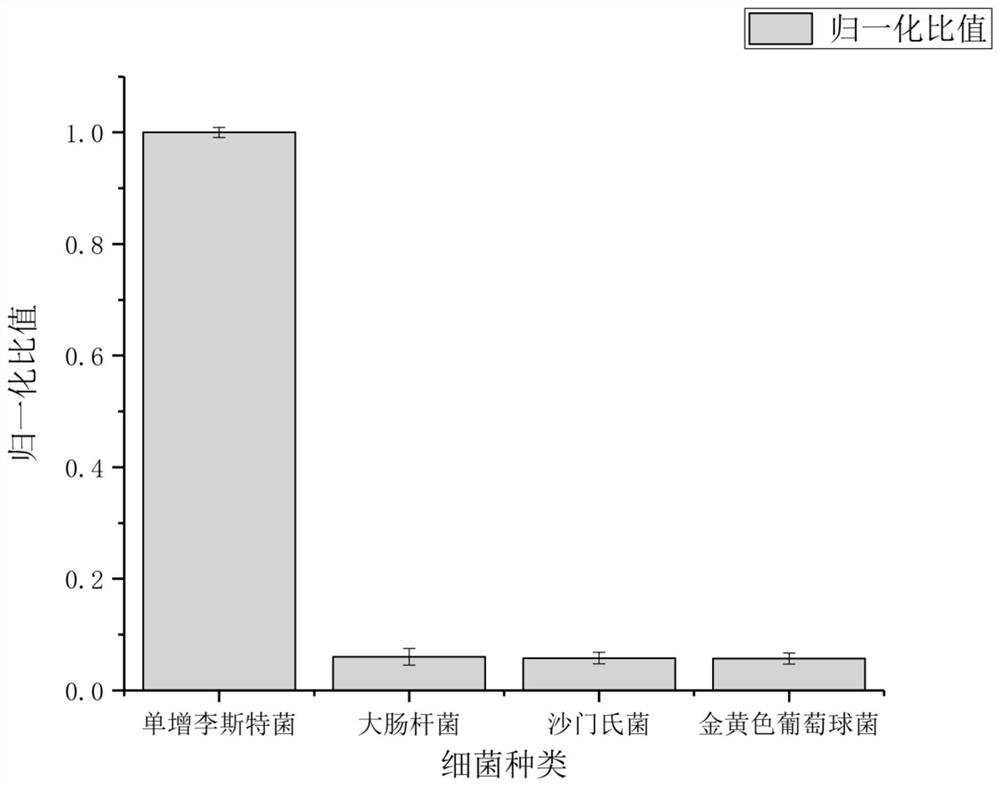A detection method for Listeria monocytogenes
A technology of Listeria monocytogenes and a detection method, which is applied in the detection field of Listeria monocytogenes, can solve the problems of cumbersome, unstable, complicated preparation steps, etc., and achieves simple and fast preparation process, improved effect, and increased contact area effect
- Summary
- Abstract
- Description
- Claims
- Application Information
AI Technical Summary
Problems solved by technology
Method used
Image
Examples
Embodiment 1
[0037] Example 1 Establishing the linear relationship between Listeria monocytogenes concentration-Raman intensity
[0038] (1) Preparation of nano-silver cage:
[0039] Add 6 mL of ultrapure water to a 10 mL centrifuge tube, place the centrifuge tube on a shaker, adjust the shaker amplitude to 700 rpm, and add 60 μL of AgNO with a mass fraction of 1% in sequence 3 solution, 12 μL of 0.5mol / L Na 2 CO 3 solution, 30 μL of 0.1 mol / L gallic acid solution, the time interval between reagent addition was kept at 5 seconds; without changing the amplitude, shake and react for 1.5 hours at room temperature and dark; remove the centrifuge tube and centrifuge at 6000rpm for 6min ; Take out the supernatant, add 5mL of ultrapure water to resuspend, and store the obtained nano-silver cage base aqueous dispersion at 4°C until use.
[0040] (2) Establish a Listeria monocytogenes standard curve:
[0041] Streak culture of pure Listeria monocytogenes (ATCC19115) species, after 12 hours of c...
Embodiment 2
[0044] Example 2 Nano silver cage substrate and simple silver nanoparticle substrate comparative detection effect
[0045] (1) Take the same volume of Listeria monocytogenes concentration as 10 2 、10 4 、10 6 The CFU / mL standard sample solution (obtained in Example 1) and the concentration of 0.2 mg / mL silver nanoparticle sol substrate are mixed in a ratio of 1:1 by volume, after vigorous shaking and mixing, incubation for 2 minutes, and the method of capillary detection Perform Raman detection. Using a Raman instrument equipped with a 785nm, 50mW near-infrared diode laser and a high-stability confocal microscope, the objective lens working distance (LWD) is 10 times, and the scanning spectral range is 400-2000cm -1 , the signal collection time is 10 seconds. After the signal is collected, the Raman software is used to perform baseline processing on the data to obtain a clear and intuitive spectrogram.
[0046] (2) According to the preparation of nano-silver cage substrate...
Embodiment 3
[0049] The effect of embodiment 3 specific detection
[0050] In order to detect the specific detection effect of the nano-silver cage substrate on Listeria monocytogenes, distilled water was used to prepare concentrations of 10 2 and 10 4 CFU / mL of Listeria monocytogenes (obtained in Example 1), Staphylococcus aureus (Staphylococcusaureus, ATCC6538), Salmonella (Salmonella, ATCC14028), Escherichia coli (Escherichia coli, ATCC700728) O157:H7 standard sample solution. Get the standard sample liquid of each strain of the same volume and nano-silver cage substrate aqueous dispersion (gained in embodiment 1) and mix with volume ratio 1: 1, after vigorous shaking and mixing, hatch 2 minutes, draw with the method for capillary detection Man detection. Raman detection and data processing methods are the same as in Example 1.
[0051] The experimental results showed that the nano-silver cage substrate only had a Raman signal enhancement effect on Listeria monocytogenes, indicating ...
PUM
| Property | Measurement | Unit |
|---|---|---|
| concentration | aaaaa | aaaaa |
| thickness | aaaaa | aaaaa |
Abstract
Description
Claims
Application Information
 Login to View More
Login to View More - R&D
- Intellectual Property
- Life Sciences
- Materials
- Tech Scout
- Unparalleled Data Quality
- Higher Quality Content
- 60% Fewer Hallucinations
Browse by: Latest US Patents, China's latest patents, Technical Efficacy Thesaurus, Application Domain, Technology Topic, Popular Technical Reports.
© 2025 PatSnap. All rights reserved.Legal|Privacy policy|Modern Slavery Act Transparency Statement|Sitemap|About US| Contact US: help@patsnap.com



